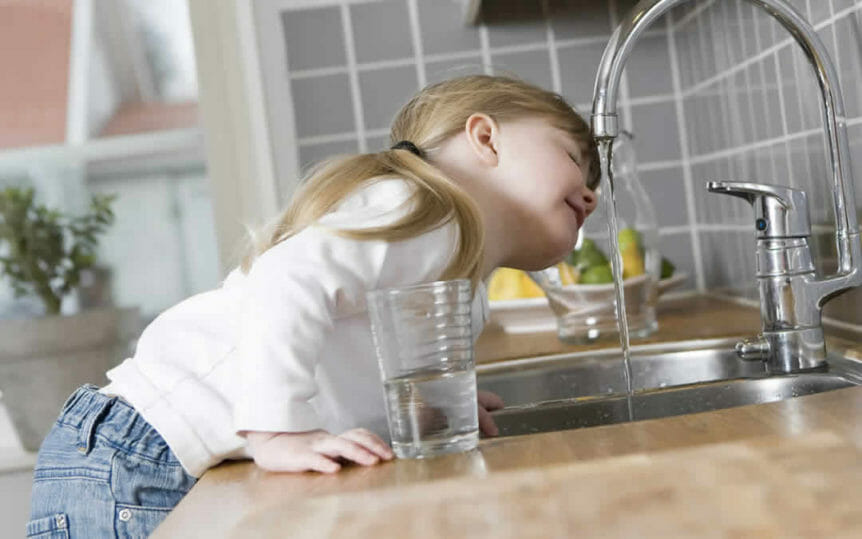
A Whole House Filtration System Delivers Great Water From The Tap
You’ve heard it before: the human body is made mostly of water, as much as 60% in fact, and the average person should drink half a gallon of water a day to give the body what it needs. And more people are drinking water these days; have you ever noticed how many different varieties water are available?
In one store alone you will see at least 4 to 5 types of water that have been cleaned and purified in a different way. There are also a variety of water purification systems and even a whole house filtration system available for the home, but what do they all mean? Understanding the different water purification processes is important and can be beneficial your health. Read on to learn about the differences between each type of water so you can decide which is the best fit for you.
Distilled Water Process
Distilled water is probably the one process that most of us are familiar with. Basically it consists of boiling water. Distillers use heat to boil water into steam. As the steam rises, it is collected and quickly turns back into the purified water that we drink. All the impurities that were in the water are left in the original heating chamber.
This process removes around 99.5 percent of all impurities and minerals from the water, which can be good and bad. It’s good because many harmful things are removed such as nitrates, bacteria, sodium, hardness, heavy metals, and dissolved solids, however some VOCs, volatile organic compounds, such as pesticides and solvents will remain. It’s bad because all minerals are removed, and our bodies need minerals to function properly. Important minerals such as potassium, chloride, magnesium, and electrolytes are stripped during this process.
If drinking distilled water is your thing, just remember that you may not be getting all the proper nutrients and minerals your body needs, and should look to getting them from other foods, vitamins, and supplements.
Reverse Osmosis
The process of reverse osmosis was developed many years ago to remove salt from seawater, and is now commonly used in many homes as a way to purify tap water. Reverse osmosis works by forcing water under pressure through a semi-permeable membrane, which will allow only certain molecules or ions to pass through. All impurities such as bacteria, viruses, heavy metals, parasites, pesticides, algae, and inorganic compounds will be flushed out, leaving behind clean water.
Like all water purification processes, there are positives and negatives. The good thing about reverse osmosis is that harsh impurities are removed, especially herbicides and pesticides, which have a tendency to be in Houston water. The not so good thing about this process is that like distilled, it removes the good with the bad. The city adds fluoride to tap water, which is beneficial to our teeth, but is removed through reverse osmosis. Also, if you cook using this type of water, it has a tendency to remove essential elements from foods. However, if you maintain a healthy diet you can get important minerals from foods and vitamins and should have nothing to worry about.
Alkaline/Ionized
Water becomes ionized through a process called electrolysis. During this process, water is run over two electrically charged plates and is separated into two streams, one is rich in hydrogen ions and is considered acidic, and the other is rich in hydroxyl and is considered alkaline. Although alkaline water can be made it can also be found naturally in certain springs across the United States.
Alkaline water has a higher PH, and is typically above 7.2. There are many benefits of drinking water with a higher PH, and according to the Mayo Clinic, it can neutralize acid in your bloodstream, boost your metabolism, help your body absorb nutrients more effectively, and can help prevent diseases.
The other type of water that is produced during electrolysis is called deionized water and is acidic, meaning it has a PH lower than 7. It is stripped of all minerals as well as impurities, and is very similar to distilled water. It is safe to drink, but by doing so your body is not receiving many benefits.
Carbon (GAC)
The Granular Activated Carbon filtration system, or more commonly known as “charcoal” filtration, purifies water by using materials that are high in carbon. As water passes through the filter, the carbon is activated and begins to remove harsh chemicals and other impurities. This filtration process is great for removing harmful organic materials along with hydrogen sulfate and chlorine, which gives water a foul smell and taste.
As you can see, there are many different types of purified water that can be purchased, but there are also a variety of home water purification systemsthat can be installed in your home so you can have clean water without having to buy it at the grocery store.
“We have two different whole house water purification systems that we install the majority of the time,” said John Moore Services Senior Operations Manager Joe Bany. “Both use carbon based media filters and they filter out all chemicals, disease, viruses, bacteria, sediment, and other impurities.”
According to Bany, not every home is ideal for a whole house water filtration system, especially if your home has galvanized pipes. Galvanized pipes have rust and sediment inside them, and if you run clean purified water through dirty galvanized pipes, your water is being contaminated as it travels through your piping system to your faucet. The solution to this problem would be to install a filtration system underneath your kitchen sink.
“If you have galvanized pipes in your home I would recommend getting a reverse osmosis system that is installed underneath the kitchen sink,” said Bany. “That way it will clean and purify all water that is coming through your kitchen faucet and you can make sure you are drinking clean water and using clean water to cook with. It’s a great option for homes that don’t qualify for a house filtration system. The only downside to a reverse osmosis filter is that there is going to be a lot of water waste, for every gallon of clean water you are throwing away 2 gallons of dirty contaminated water.”
When it comes to purified water, there are many options available. Whatever way you decide to go, the most important thing to remember is to make sure your water is clean. Drinking dirty, contaminated, unpurified water can be hazardous to your health and especially dangerous for children and the elderly. John Moore Services has many different purification devices available, and our technicians will work to find the best option for your home, and will even test your water. Give us a call today!
